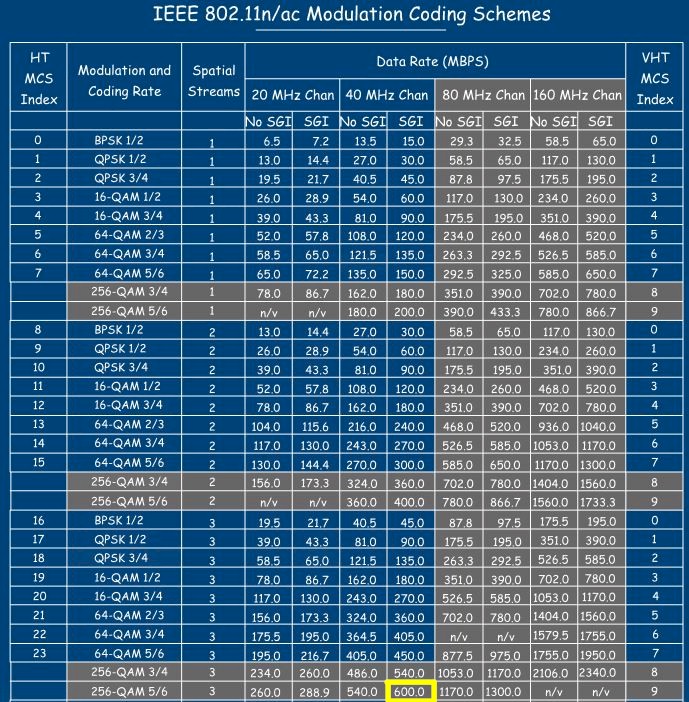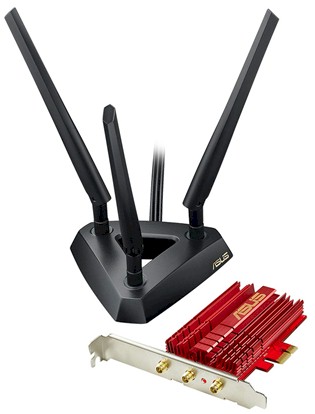Introduction
Since AC1900 routers are starting to appear, I thought it a good idea to arm you with some essential information before you plunk down $200+ on something that may not provide any benefit.
This new class of router has been dreamed up by Broadcom in hopes of locking people into its 802.11ac platform. The short story is that these routers use Broadcom’s classic 3×3 BCM4360 5G WiFi 3-Stream 802.11ac Gigabit Transceiver for both the 5 GHz and 2.4 GHz radios. In contrast, AC1750 class routers use an 802.11ac device for the 5 GHz radio and a 802.11n device for 2.4 GHz to save a little cost.
Broadcom has tweaked its drivers to enable 256-QAM modulation and coding when the BCM4360 is switched to 2.4 GHz as well as 5 GHz. 256-QAM is a higher density coding scheme that, along with 80 MHz bandwidth, enables the 1300 Mbps maximum link rate that 802.11ac provides. 256-QAM is part of the 802.11ac standard. But to sprinkle a little marketing pixie dust on it, Broadcom has dubbed it "TurboQAM". This version of "TurboQAM" should not be confused with Broadcom’s earlier use of the moniker with its DOCSIS 2.0 cable modem chips.
Since 80 MHz bandwidth isn’t possible in 2.4 GHz but 40 MHz is, 256-QAM gets you only 600 Mbps in the 2.4 GHz band vs. 1300 Mbps in 5 GHz. I’ve highlighted the 600 Mbps link rate in the Modulation Coding Scheme (MCS) table below to show where it comes from.

802.11n/ac MCS table
(courtesy WITS via Aerohive blog)
Caveat Emptor
What the companies promoting AC1900 don’t want you to know is that most people will never experience the 600 Mbps link rate promoted by AC1900 routers. That’s because three things are needed:
1) An AC1900 class router
2) An AC1900 class client
3) 40 MHz bandwidth
The first two requirements are obvious. But getting your hands on an AC1900 class client isn’t easy because only one exists: the ASUS PCE-AC68. This is a half-height PCIe board designed for desktop computers (remember those?), which is obvious from the product shot below.

ASUS PCE-AC68
Note that if you have the PCE-AC68’s predecessor, the PCE-AC66, like I do, you can’t get an updated driver for it that will enable TurboQAM. Turbo-QAM is only supported on the PCE-AC68. ASUS supposedly is going to have an exchange program to swap out your PCE-AC66 for a PCE-AC68. But there is no sign of this on either the PCE-AC66 or PCE-AC68 ASUS product pages. So consider this only a rumor for now.
The more feasible way to get 600 Mbps in 2.4 GHz, albeit more expensive, will be to buy two AC1900 routers and use the second as a bridge to the first. This raises your chances of actually experiencing the 600 Mbps link rate. The only problem is, you won’t be able to know for sure, because routers don’t show their connection link rate. They could, but neither the ASUS RT-AC68U nor NETGEAR R7000 display the value in their admin GUIs. Perhaps Linksys EA6900 will, but I haven’t seen it yet in any router, even for normal (non-bridge) clients.
The last requirement is the icing on the cake. 802.11n and ac products are supposed to support 40 MHz coexistence and obey the Fat Channel intolerant bit a client can set. This means that if an interfering network is in range, the router is supposed to fall back to using 20 MHz link rates.
Consulting the MCS table above, this means that if you have a full AC1900 client, the maximum link rate will be only 260 Mbps (or 288.9 if you are lucky). But the more interesting tidbit is that the mobile clients that use Broadcom 1×1 or 2×2 (much less common) radios won’t be able to support the highest 256-QAM link rates. (This is represented by "n/v" in the MCS table above.) While they will get higher link rates than they otherwise would with an AC1750 router, the speed will be a far cry from the 600 Mbps being used as a come-on to get router selling prices back above $200.
It’s also important to note that AC1750 routers can’t be upgraded to AC1900 via firmware update. As noted earlier, the 2.4 GHz radio must use an 802.11ac device, not the 802.11n radio that all products have used until now.
Bottom Line
The last reason you should be buying an AC1900 router is in hope of "future proofing" your network. If AC1900 routers manage to get traction and stick around, you can be sure that less expensive versions will follow by the time that there are mobile devices that actually can take advantage of it…at link rates below 600 Mbps, of course.
Since 256-QAM isn’t proprietary to Broadcom, it is possible that other chipmakers could choose to support it in their 802.11ac devices. In fact, when I asked Qualcomm whether they plan to support 256-QAM in its 802.11ac VIVE products, they said:
We think there’s advantage to be gained when 256 QAM in 2.4 GHz is on both the client and router sides of the link, and of course, there’s the growing marketing check box that we must address. We will enable the feature in a complete ecosystem near-term.
For now however, Broadcom is the only AC1900 game in town and is used by the first round of AC1900 routers from ASUS (RT-AC68U), NETGEAR (R7000) and Linksys (EA6900).
There may be other reasons to buy an AC1900 class router, including faster file sharing performance from the USB storage sharing that all support. And better wireless performance is possible, too. But improved performance is more likely to come from faster processors (like the Broadcom BCM4709) that may be used in AC1900 routers (NETGEAR’s R7000 being one). 2.4 GHz performance at standard link rates might be improved too, due to the use of newer 11ac devices for the 2.4 GHz radio instead of older N class chips.
I suspect that AC1900 will become like 3D TV. When first introduced, the consumer electronics industry hoped we would all throw away our just-purchased HD sets and rush out to buy 3D replacements, along with the glasses, disc players and new source material required for the "full 3D experience". Instead, sanity prevailed and 3D moved from being a primary selling point to an oh-by-the-way-it-does-3D-too feature that not many people end up using.
In the end, the best justification for buying an AC1900 router won’t be for the 2.4 GHz 600 Mbps link rate, but for a higher-performance design that will deliver benefit for the clients you already have.
